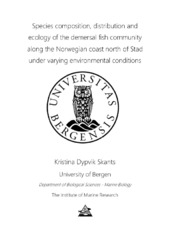| dc.description.abstract | In the last decades, temperatures of the Atlantic current that enters the Norwegian Coastal Current (NCC) has been above the yearly average, with 2007 as the warmest registration on record (Skagseth 2012). The climatic changes in recent years are likely to have large-scale ecological consequences for the marine demersal fish-populations, especially in arctic latitudes. Many studies have been conducted in areas of the Barents Sea related to the community structure of marine fish, while little is still known about these changes in areas bordering the Norwegian Sea. This study uses catch and CTD data collected in both coastal areas/inner fjords and open ocean bank areas between Stad (62 oN) and Varanger (71.3 oN) by The Institute of Marine Research (IMR) from 1995, 2005 and 2017. This thesis investigates the changes found in distribution, composition and species richness in areas of the Norwegian coast for 86 marine demersal fish from 33 different families in the last 20 years and represent an essential knowledge baseline about both commercial and non-commercial species in this area that has previously been an area of little focus. The data show that there has been marked northward shifts in spatial distribution for the majority of species. Many increased clearly in abundance at high latitudes in the warmer years, hinting at more favourable conditions due to climate change, which are leading species to become more established in these areas. Such trends are most pronounced for large, boreal generalist such as cod (Gadus morhua), Norway redfish (Sesbastes viviparus) and whiting (Merlangius merlangus). A large number of demersal species have been registered in 2005 and 2017 that were not present along the Norwegian coast in 1995. There has also been an observed shift for many species to move further from the coast, and into open ocean areas in more recent years. The trends observed are overall consistent with the recorded increases in temperatures of the same years, supporting a claim of a large-scale climate related changes in distribution and abundance. Finally, the data revealed that species composition has changed significantly on a south-north gradient between the years. Species composition from 1995 to 2017 was also found being significantly (p<0.05) related to the changes (i.e. increase) in temperature, fishing depth and the eight subareas investigated along the Norwegian coast. | en_US |
